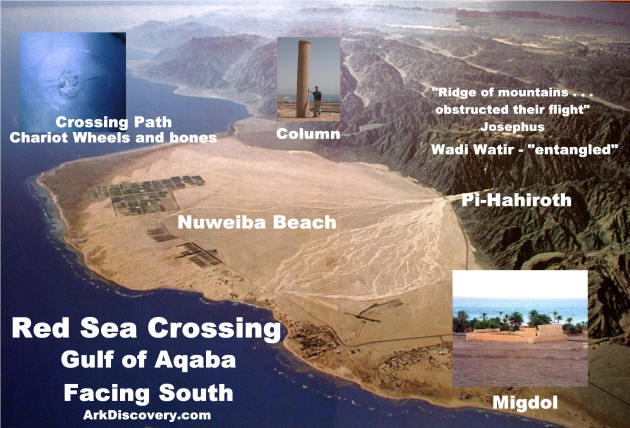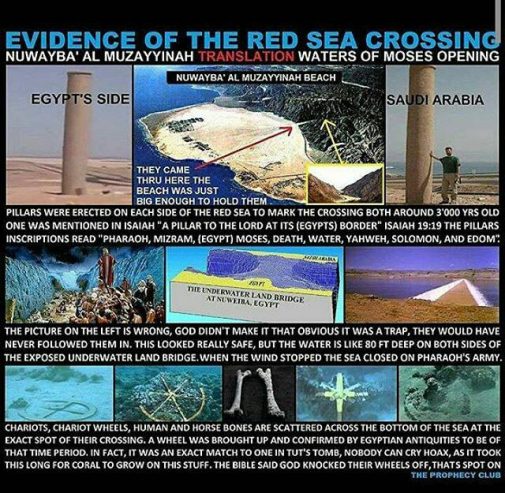The Credibility of The Bible - The Crossing of The Red Sea

A few years ago, scientists found a large ancient 4.7-meter-tall granite pole on the Red Sea coast weighing 11.5 tons. The Red Sea coastline on which this pillar is located belongs to the Egyptian Gulf of Nuvib Peninsula. The scientists were amazed. Whence the granite pillar in this place, when the closest granite site can be found in southern Egypt?
An even bigger surprise was the discovery of the same such ancient granite pillar on the opposite shore of the Red Sea, which today belongs to Saudi Arabia. After this discovery, the Saudi authorities transferred this pillar to the museum and installed a metal flag and plaque in its place.
The question was: What are these ancient pillars? The answer began to emerge when scientists discovered that the same ancient granite pillars exist in Israel.
Historians knew that the Israeli emperor Solomon had ships and was on good terms with the Egyptian emperor. This was the reason for those historians, who accepted Moses history as correct, to suggest that perhaps Solomon had erected these granite pillars as a memorial to the Israelites crossing the Red Sea.
Also, historians have noticed that other details in Moses’ description fit neatly into the scenario of a possible crossing of the Israelites across the Red Sea at the place where the granite columns were found. Namely, Moses wrote that after leaving Egypt, the Israelites first reached the “end of the desert”, then “turned” their course and reached the Red Sea coast.
Although this whole region is called desert because of the lack of water, on this road to the Red Sea there are oases, and on the very half of the island, where the granite pillar is located, there is an ancient well that still contains water today. All this has further fueled the hope of historians that these pillars represent the memory of the Israelites crossing the Red Sea.
However, the Red Sea is very deep in the Arabian Gulf. In the northern part of this bay, it is about 900 meters deep, and in the southern part about 1900 meters. The distance from one coast to another is about 14 kilometers. At such depths, the slope of the seafloor is so great that even in the event of separation of the sea, crossing would be impossible because the crossing path would be too steep for humans and animals.

But then a new discovery ensued. Exactly at the point where the granite columns were found, scientists discovered an underwater reef, so at that point the maximum depth of the sea is only about 80 meters. The seafloor slope here is very gentle and favorable for the eventual crossing. All of these findings were enough for scientists to rent a boat, divers and cameras, and explore the bottom of the Red Sea at this point.
Moses wrote that after the passage of the Israelites across the bottom of the divided sea, Pharaoh and his army followed after them, and then the water flooded them. If such a thing really happened, it was assumed that the remains of Pharaoh’s army might be found at this bottom.
It is known from history that Pharaoh and his soldiers used chariots made of wood and leather. In some cases, the wheels were gilded. If such carriages were to reach the seafloor, the skin would fall apart and corals would settle on the wooden parts. Wood would be decomposed and corals would take its shape.
When divers searched the bottom of the Red Sea on this reef, they found a large number of coral structures that occupy the shape of wheels and overturned carriages.
Corals are known to grow normally forming clumps, not structures like this.

Finally, the divers also found one gilded wheel that was not decomposed by the coral. In addition to the remains of the carriages, a large number of fossilized bones of humans and horses were found.
Because the currents of water are very strong on this underwater reef, scientists assume that there are even more such remnants of Pharaoh’s army that have been carried over time to the greater depths of the Arabian Gulf. Exploration of such depths requires special and very expensive equipment, such as the one with which the sinking ship Titanic was explored. Nevertheless, the granite pillars on opposite shores of the Red Sea, as well as the finds at the bottom of the sea, right along the line connecting these pillars, were sufficient proof to scholars to confirm the authenticity of the history recorded by Moses.
But they didn’t stop there. Knowing that Moses had recorded the more incredible events that followed the crossing of the Red Sea, they set out to explore the opposite coast – one that belongs to present-day Saudi Arabia.
